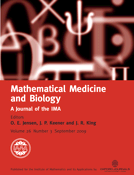-
Views
-
Cite
Cite
Abbey J. Trewenack, Colin P. Please, Kerry A. Landman, A continuum model for the development of tissue-engineered cartilage around a chondrocyte, Mathematical Medicine and Biology: A Journal of the IMA, Volume 26, Issue 3, September 2009, Pages 241–262, https://doi.org/10.1093/imammb/dqp013
Close - Share Icon Share
Abstract
The limited ability of cartilage to repair when damaged has led to the investigation of tissue engineering as a method for reconstructing cartilage. We propose a continuum multispecies model for the development of cartilage around a single chondrocyte. As in healthy cartilage, the model predicts a balance between synthesis, transport, binding and decay of matrix components. Two mechanisms are investigated for the transport of soluble matrix components: diffusion and advection, caused by displacement of the scaffold medium. Numerical results indicate that a parameter defined by the ratio of the flux of soluble components out of the chondrocyte and its diffusive flux determines which of these mechanisms is dominant. We investigate the diffusion-dominated and advection-dominated limiting cases using perturbation analysis. Using parameter values from the literature, our modelling results suggest that both diffusion and advection are significant mechanisms in developing cartilage. Moreover, in this parameter regime, results are particularly sensitive to parameter values. These two observations could explain differences observed experimentally between various scaffold media. Modelling results are also used to predict the minimum chondrocyte seeding density required to produce functional cartilage.





